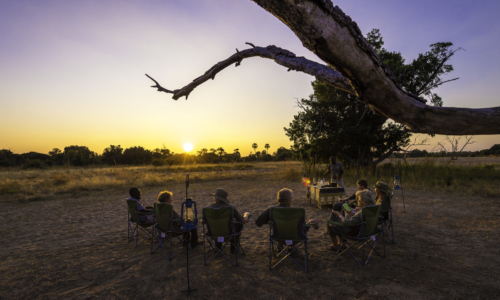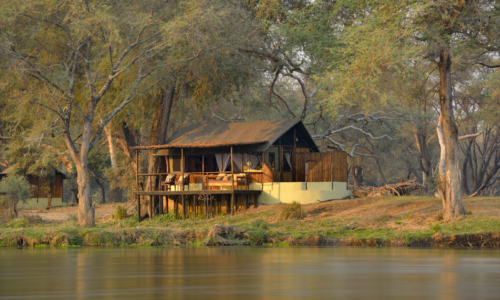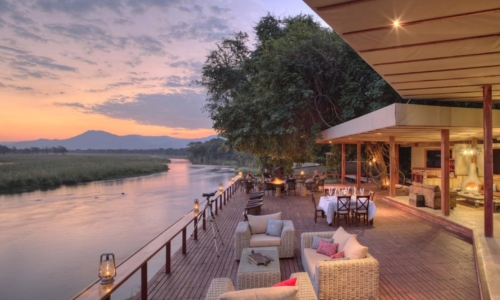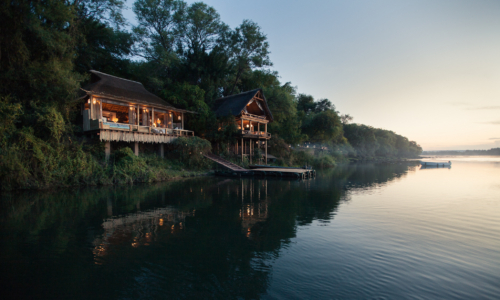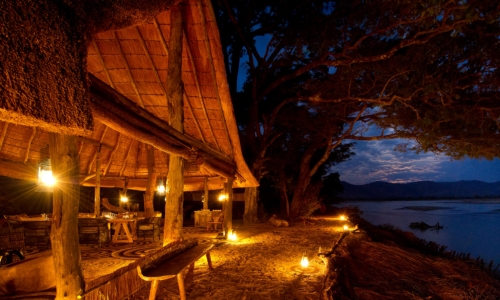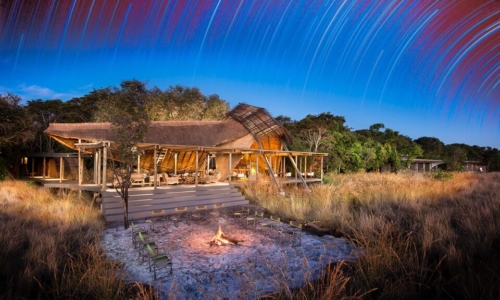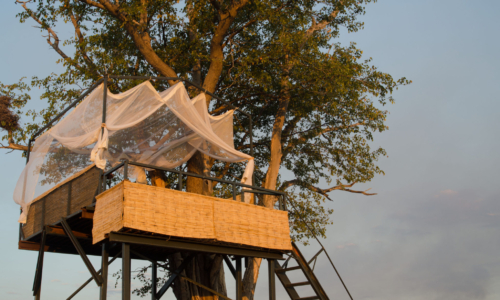Named for the Kafue River, the remote park was established in 1924 by the British colonial government but to this day remains largely unexplored. Bisected from north to south by the broad slow-flowing Kafue River, the park’s fertile grasslands and miombo and mopane woodlands attract incredible concentrations of wildlife. The jewel of Kafue is the Busanga Plains in the northern section of the park. Busanga is a vast floodplain of the Lufupa tributary, and for much of the year the plains are submerged below seasonal floodwaters. At around 4,000 feet, the region has a somewhat milder climate than the lower Zambezi and Luangwa valleys. During the wet season, the park is at its most lush and viral, but some areas can become inaccessible.
The floodplains of Kafue National Park are home not just to hundreds of bird species, but to herds of sitatunga, red lechwe, puku, impala, wildebeest, hartebeest, buffalo, and zebra, all of which in turn support impressive populations of lion, leopard, and cheetah. There are a recorded 495 birds in the area including Ross’s turaco, Narina trogons, MacClounie’s barbet, olive woodpecker, brown-headed apalis, and the yellow-throated leaflove. Crocodiles and pods of hippos inhabit nearly all stretches of the Kafue River and its major tributaries. The Park also has a large population of African wild dog with packs.
In recent decades, the Kafue elephant population has rebounded from illegal poaching during the 1980s and 1990s. Though the number of elephants has dwindled down from 60,000 to 4,000. Unfortunately, Kafue had one of the largest rhino populations in Africa but due to poaching there isn’t one single rhino left in the Park.
The dry season is the best time for 4×4 game drives which are offered at many of the local safari lodges and camps with an expert guide. Self-driving is available in certain areas like the M9. For a closer look at the flora and fauna, many of the local camps offer guided bush walks with an armed guard. At any time of the year, visitors can enjoy cruises on the Kafue River, although water levels can change. Canoeing trips are available from places like Kaingu with the Mawimbi Canoe Trails. Anglers can enjoy fishing the rivers, but there are restrictions on how many fish can be catch to allow for breeding. Because the Busanga Plain is a floodplain, it is only accessible between early July to early November.

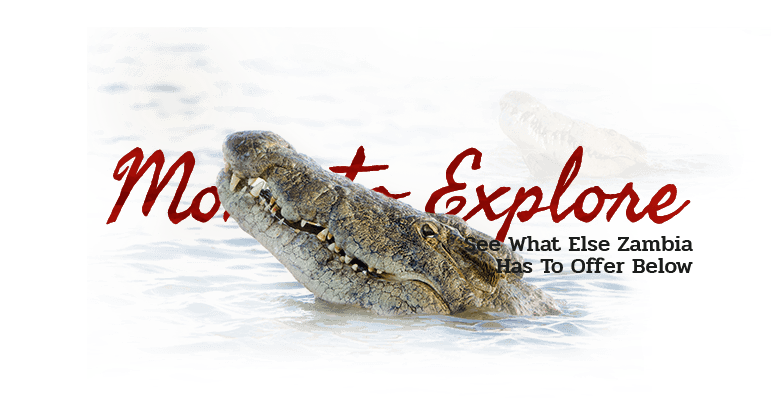
- Baines’ River Camp
- Bilimungwe Bushcamp
- Busanga Bush Camp
- Chamilandu Bushcamp
- Chiawa Camp
- Chichele Presidential Lodge
- Chindeni Bushcamp
- Chinzombo
- Chongwe Camp
- Kaingo Camp
- Kakuli Camp
- Kapamba Bushcamp
- King Lewanika
- Kuyenda Bushcamp
- Lion Camp
- Lolebezi Safari Lodge
- Luangwa River Camp
- Luwi Camp
- Mchenja Camp
- Mfuwe Lodge
- Mwamba Camp
- Nkwali
- Nsefu Camp
- Nsolo Camp
- Old Mondoro
- Potato Bush Camp
- Puku Ridge Camp
- Royal Zambezi Lodge
- Sausage Tree Camp
- Shumba Camp
- Sindabezi Island
- Sungani Lodge
- Sussi & Chuma
- Tena Tena Lodge
- The River Club
- Thorntree River Lodge
- Tintswalo at Siankaba
- Toka Leya Camp
- Tongabezi
- Zungulila Bushcamp
Coming soon!
- Baines’ River Camp
- Bilimungwe Bushcamp
- Busanga Bush Camp
- Chamilandu Bushcamp
- Chiawa Camp
- Chichele Presidential Lodge
- Chindeni Bushcamp
- Chinzombo
- Chongwe Camp
- Kaingo Camp
- Kakuli Camp
- Kapamba Bushcamp
- King Lewanika
- Kuyenda Bushcamp
- Lion Camp
- Lolebezi Safari Lodge
- Luangwa River Camp
- Luwi Camp
- Mchenja Camp
- Mfuwe Lodge
- Mwamba Camp
- Nkwali
- Nsefu Camp
- Nsolo Camp
- Old Mondoro
- Potato Bush Camp
- Puku Ridge Camp
- Royal Zambezi Lodge
- Sausage Tree Camp
- Shumba Camp
- Sindabezi Island
- Sungani Lodge
- Sussi & Chuma
- Tena Tena Lodge
- The River Club
- Thorntree River Lodge
- Tintswalo at Siankaba
- Toka Leya Camp
- Tongabezi
- Zungulila Bushcamp
Coming soon!

Named for the Kafue River, the remote park was established in 1924 by the British colonial government but to this day remains largely unexplored. Bisected from north to south by the broad slow-flowing Kafue River, the park’s fertile grasslands and miombo and mopane woodlands attract incredible concentrations of wildlife. The jewel of Kafue is the Busanga Plains in the northern section of the park. Busanga is a vast floodplain of the Lufupa tributary, and for much of the year the plains are submerged below seasonal floodwaters. At around 4,000 feet, the region has a somewhat milder climate than the lower Zambezi and Luangwa valleys. During the wet season, the park is at its most lush and viral, but some areas can become inaccessible.
The floodplains of Kafue National Park are home not just to hundreds of bird species, but to herds of sitatunga, red lechwe, puku, impala, wildebeest, hartebeest, buffalo, and zebra, all of which in turn support impressive populations of lion, leopard, and cheetah. There are a recorded 495 birds in the area including Ross’s turaco, Narina trogons, MacClounie’s barbet, olive woodpecker, brown-headed apalis, and the yellow-throated leaflove. Crocodiles and pods of hippos inhabit nearly all stretches of the Kafue River and its major tributaries. The Park also has a large population of African wild dog with packs.
In recent decades, the Kafue elephant population has rebounded from illegal poaching during the 1980s and 1990s. Though the number of elephants has dwindled down from 60,000 to 4,000. Unfortunately, Kafue had one of the largest rhino populations in Africa but due to poaching there isn’t one single rhino left in the Park.
The dry season is the best time for 4×4 game drives which are offered at many of the local safari lodges and camps with an expert guide. Self-driving is available in certain areas like the M9. For a closer look at the flora and fauna, many of the local camps offer guided bush walks with an armed guard. At any time of the year, visitors can enjoy cruises on the Kafue River, although water levels can change. Canoeing trips are available from places like Kaingu with the Mawimbi Canoe Trails. Anglers can enjoy fishing the rivers, but there are restrictions on how many fish can be catch to allow for breeding. Because the Busanga Plain is a floodplain, it is only accessible between early July to early November.

- Baines’ River Camp
- Bilimungwe Bushcamp
- Busanga Bush Camp
- Chamilandu Bushcamp
- Chiawa Camp
- Chichele Presidential Lodge
- Chindeni Bushcamp
- Chinzombo
- Chongwe Camp
- Kaingo Camp
- Kakuli Camp
- Kapamba Bushcamp
- King Lewanika
- Kuyenda Bushcamp
- Lion Camp
- Lolebezi Safari Lodge
- Luangwa River Camp
- Luwi Camp
- Mchenja Camp
- Mfuwe Lodge
- Mwamba Camp
- Nkwali
- Nsefu Camp
- Nsolo Camp
- Old Mondoro
- Potato Bush Camp
- Puku Ridge Camp
- Royal Zambezi Lodge
- Sausage Tree Camp
- Shumba Camp
- Sindabezi Island
- Sungani Lodge
- Sussi & Chuma
- Tena Tena Lodge
- The River Club
- Thorntree River Lodge
- Tintswalo at Siankaba
- Toka Leya Camp
- Tongabezi
- Zungulila Bushcamp
Coming soon!
- Baines’ River Camp
- Bilimungwe Bushcamp
- Busanga Bush Camp
- Chamilandu Bushcamp
- Chiawa Camp
- Chichele Presidential Lodge
- Chindeni Bushcamp
- Chinzombo
- Chongwe Camp
- Kaingo Camp
- Kakuli Camp
- Kapamba Bushcamp
- King Lewanika
- Kuyenda Bushcamp
- Lion Camp
- Lolebezi Safari Lodge
- Luangwa River Camp
- Luwi Camp
- Mchenja Camp
- Mfuwe Lodge
- Mwamba Camp
- Nkwali
- Nsefu Camp
- Nsolo Camp
- Old Mondoro
- Potato Bush Camp
- Puku Ridge Camp
- Royal Zambezi Lodge
- Sausage Tree Camp
- Shumba Camp
- Sindabezi Island
- Sungani Lodge
- Sussi & Chuma
- Tena Tena Lodge
- The River Club
- Thorntree River Lodge
- Tintswalo at Siankaba
- Toka Leya Camp
- Tongabezi
- Zungulila Bushcamp
Coming soon!






 Safari Camps
Safari Camps Points of Interest
Points of Interest Hotels & Resorts
Hotels & Resorts  Journeys
Journeys












